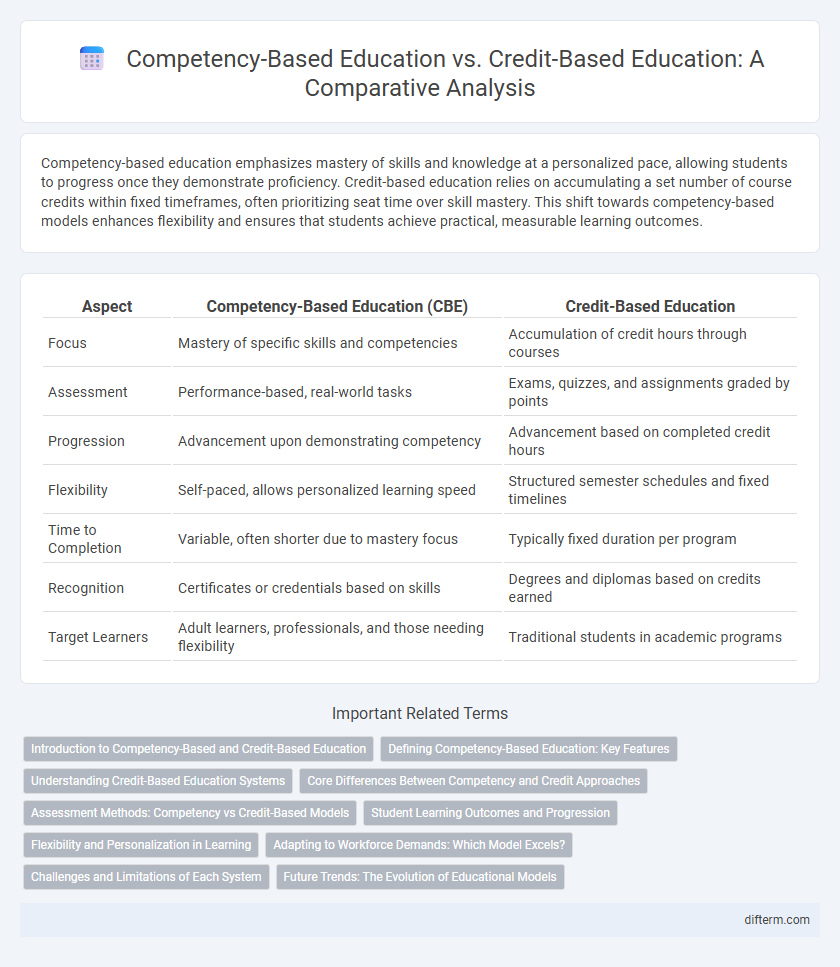Competency-based education emphasizes mastery of skills and knowledge at a personalized pace, allowing students to progress once they demonstrate proficiency. Credit-based education relies on accumulating a set number of course credits within fixed timeframes, often prioritizing seat time over skill mastery. This shift towards competency-based models enhances flexibility and ensures that students achieve practical, measurable learning outcomes.
Table of Comparison
| Aspect | Competency-Based Education (CBE) | Credit-Based Education |
|---|---|---|
| Focus | Mastery of specific skills and competencies | Accumulation of credit hours through courses |
| Assessment | Performance-based, real-world tasks | Exams, quizzes, and assignments graded by points |
| Progression | Advancement upon demonstrating competency | Advancement based on completed credit hours |
| Flexibility | Self-paced, allows personalized learning speed | Structured semester schedules and fixed timelines |
| Time to Completion | Variable, often shorter due to mastery focus | Typically fixed duration per program |
| Recognition | Certificates or credentials based on skills | Degrees and diplomas based on credits earned |
| Target Learners | Adult learners, professionals, and those needing flexibility | Traditional students in academic programs |
Introduction to Competency-Based and Credit-Based Education
Competency-based education (CBE) emphasizes mastery of specific skills and knowledge, allowing students to progress at their own pace upon demonstrating proficiency. Credit-based education traditionally relies on time-based measures, where students accumulate credits through completing courses over fixed semesters. CBE offers personalized learning pathways and real-world skill validation, contrasting with the standardized structure of credit accumulation in conventional education systems.
Defining Competency-Based Education: Key Features
Competency-based education (CBE) emphasizes mastery of specific skills and knowledge over seat time or credit hours, allowing students to progress at their own pace upon demonstrating proficiency. Key features include personalized learning pathways, clear competency frameworks aligned with industry standards, and frequent formative assessments to measure skill acquisition. CBE shifts the focus from traditional credit accumulation to outcomes-based achievements, ensuring graduates possess job-ready capabilities.
Understanding Credit-Based Education Systems
Credit-based education systems organize learning around credits that quantify the amount of time spent in classes, typically requiring students to accumulate a specific number of credits to graduate. This system emphasizes seat time and course completion over skill mastery, allowing students to progress by meeting credit thresholds rather than demonstrating competencies. Understanding credit-based education involves recognizing its framework for scheduling, assessment, and standardized progression, which contrasts with the flexible pacing and outcome-focused nature of competency-based education.
Core Differences Between Competency and Credit Approaches
Competency-based education measures student progress through demonstrated mastery of specific skills and knowledge, while credit-based education relies on time spent in class and seat hours to assign grades. Competency approaches focus on personalized learning paths and practical application, ensuring learners achieve proficiency before moving forward, compared to credit systems that prioritize course completion regardless of individual understanding. This core difference impacts flexibility, assessment methods, and the alignment of educational outcomes with workforce demands.
Assessment Methods: Competency vs Credit-Based Models
Competency-based education employs mastery-oriented assessments that evaluate students' skills and understanding through practical demonstrations and real-world applications, ensuring deep comprehension before progression. Credit-based education relies on standardized testing and accumulation of credits based on seat time and course completion, often emphasizing time spent rather than skill proficiency. The assessment methods in competency models prioritize individualized learning outcomes, whereas credit models focus on uniform metrics tied to coursework and credit hours.
Student Learning Outcomes and Progression
Competency-based education emphasizes mastery of specific skills and knowledge, allowing students to progress upon demonstrating proficiency, which directly enhances measurable student learning outcomes. Credit-based education relies on accumulating fixed credit hours, often prioritizing time spent over actual skill acquisition, potentially leading to varying levels of student proficiency. Focusing on student progression through competencies ensures personalized learning pathways and better alignment with workforce requirements.
Flexibility and Personalization in Learning
Competency-based education offers greater flexibility by allowing students to progress at their own pace, mastering specific skills before moving forward, unlike credit-based education which relies on fixed timeframes and seat hours. Personalized learning in competency-based models adapts to individual student needs, providing tailored assessments and targeted support to ensure mastery of competencies. Credit-based education, by contrast, often follows a more standardized curriculum with limited customization, potentially hindering personalized learning experiences.
Adapting to Workforce Demands: Which Model Excels?
Competency-based education (CBE) aligns more effectively with workforce demands by emphasizing mastery of specific skills and practical knowledge directly applicable to job roles, unlike traditional credit-based education which often prioritizes time spent in class over demonstrated abilities. Employers increasingly value CBE graduates for their proven competencies and readiness to perform in real-world settings, facilitating faster integration into evolving industries. This model's flexibility also supports lifelong learning and continuous skill development crucial for adapting to rapid technological advancements.
Challenges and Limitations of Each System
Competency-based education faces challenges such as inconsistent assessment standards and difficulties in scaling personalized learning across diverse populations. Credit-based education struggles with limitations including a rigid time structure that may not reflect actual skill mastery and potential disengagement due to standardized pacing. Both systems encounter hurdles in aligning curricula with real-world skills and ensuring equitable access to quality resources.
Future Trends: The Evolution of Educational Models
Competency-based education (CBE) increasingly replaces traditional credit-based education by emphasizing mastery of specific skills and knowledge rather than time spent in class, aligning education with workforce demands. Future trends indicate a rise in personalized learning paths enabled by digital platforms and data analytics, allowing learners to progress at their own pace while demonstrating competency through assessments. This evolution supports lifelong learning and adaptability, key factors in preparing students for rapidly changing career landscapes.
Competency-based education vs credit-based education Infographic

 difterm.com
difterm.com